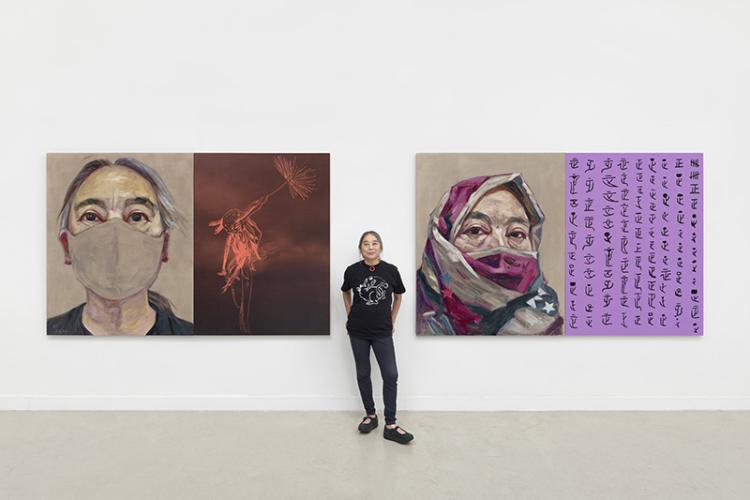
Hung Liu in her studio with “Rat Year 2020,” painted in 2020. Artwork is oil on linen and mixed media on wood panel, diptych. Photo by John Janca. Artwork © Hung Liu.
When we consider women's history, well-known names often come to mind. Names such as Maya Angelou, Angela Davis, or Susan B. Anthony might come to mind. But how can we look beyond well-known stories?
Chinese-born American artist Hung Liu's portraits remind us that history also includes many people whose voices have gone unheard. Her artwork often features orphaned children, women soldiers, refugees, comfort women, and migrant laborers. Liu, who died in 2021, described her subjects as lost souls or "spirit-ghosts." Since the 1980s, she honored hundreds of anonymous individuals through her artwork.
Liu used historic photographs as source material for her large canvases. She worked in layers, first painting from the original photograph subjects but cropping the original image and adding color and texture. Then she added symbolic shapes, including butterflies and lotus flowers. For final layers, she created a veil-like covering by adding generous amounts of linseed oil to dilute her oil paint.
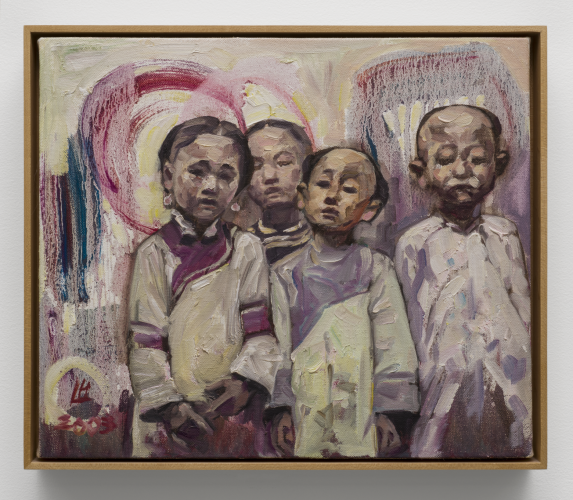
“Mission Girls 20” by Hung Liu, 2003. Oil on canvas. Castellano-Wood Family Collection. © Hung Liu
Liu said that she created this method in contrast to idealized Chinese propaganda images. "I realized...the oil paints ran," she said. "It's the gravity doing the job. The washes and drips create a visual veil. I create the image, but [in] the meanwhile I see if the image will be destroyed, at least blurred some part... I just think that's more interesting than the solid, perfectly rendered image...Even though the painting, after so many years, it's totally dry, but feels still runny. To me, history to me is not a noun, it's a verb. It's still going on."
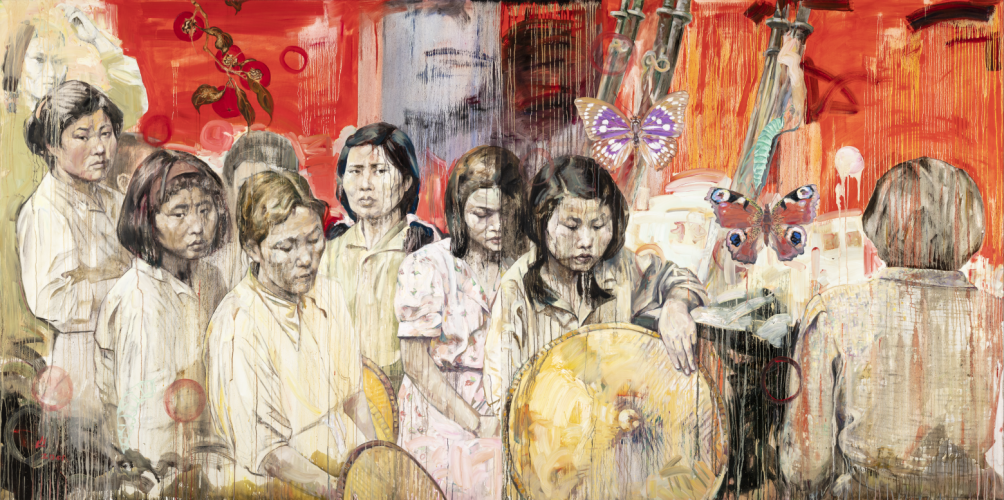
“Strange Fruit: Comfort Women” by Hung Liu, 2001. Oil on canvas. Karen and Robert Duncan Collection. © Hung Liu
Curator Dorothy Moss said that final layer of paint separates the viewer from the subject of the artwork. She says, "Liu created a veil between the subject and the viewer as a reminder of the passage of time and the intricacies of memory. Hung Liu's canvases are rich in texture and symbolism. Each time I look at her paintings, I see something new."
Liu's life and artwork highlight complexities of Asian American experiences. She was born in Changchun, China, in 1948. Her art reflects war, political revolution, exile, and the displacement she experienced in China. In her early twenties she was forced into field labor during President Mao Zedong's Cultural Revolution. She later studied art in Beijing. In 1984, Liu left China to attend graduate school in San Diego, California.
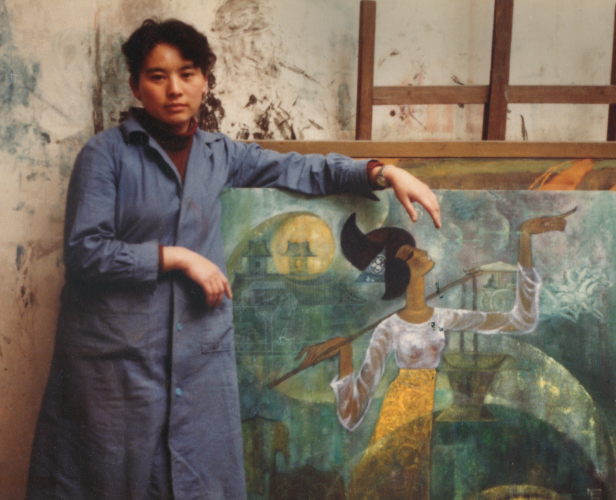
Hung Liu as a graduate student at Central Academy of Fine Arts, Beijing, China, 1980. Reproduction after the original photograph. Courtesy of Hung Liu and Jeff Kelley.
Notable works in Hung Liu: Portraits of Promised Lands also include self-portraits and works of her family members.
After immigrating to the United States for graduate study at the University of California at San Diego, Liu met her future husband, art critic Jeff Kelley, and decided to make her move permanent. Liu painted a large-scale rendering of her green card, the document which shows that a person has permanent residency in the United States. She was surprised to see "resident alien" on her card. The science fiction movie Aliens came out two years after she immigrated, and the card made her think about the film's extraterrestrial life forms. "Oh God, I'm alien," Liu remembered thinking. "It's ironic. I'm a resident, I'm legal, yet I'm still alien."
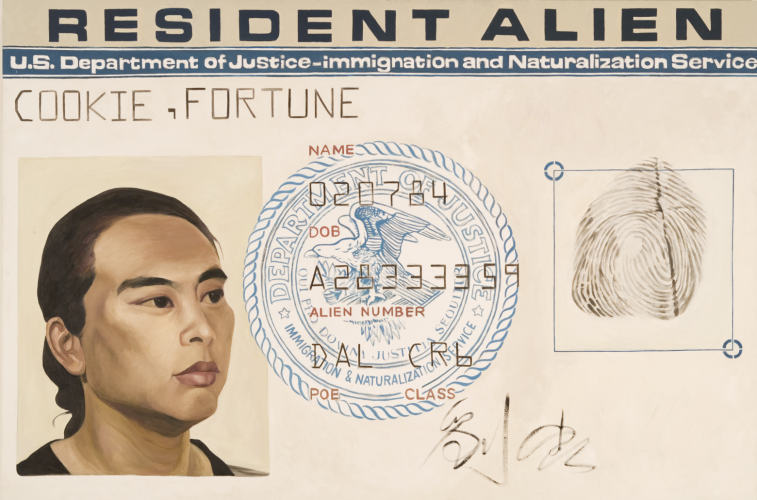
“Resident Alien” by Hung Liu, 1988. Oil on canvas. Collection of the San Jose Museum of Art. Gift of the Lipman Family Foundation. ©Hung Liu
When painting her green card, Liu made a few changes. She switched her birthday to 1984, the year she immigrated. She also changed her name to Fortune Cookie. Liu first encountered fortune cookies at an American Chinese restaurant. A fellow graduate student assumed she would be familiar with the cookies since she was Chinese, but fortune cookies were likely invented by Makoto Hagiwara, a Japanese American man in San Francisco. The cookies are a hybrid and a product of the immigrant experience.
In this conceptual self-portrait, Liu uses a sense of irony and humor to speak to the curiosities and pains of the immigration experience. The work is one of many by Liu reflecting migrant experiences.
Moss said, "Hung Liu was always aware of the vulnerability of refugees, especially women and children. Her work resonates powerfully today as stories of refugees seeking a better life in the United States proliferate in the news."
Liu also recognized that her work speaks powerfully to the present. "History is not a static image or a frozen story," Liu said. "It is always flowing forward.
See Hung Liu: Portraits of Promised Lands in person at the National Portrait Gallery in Washington, D.C. now through May 30, 2022. You can also take a virtual tour of selected works from the exhibition, narrated by curator Dorothy Moss.
Related Posts
- Hung Liu: Portraits of Promised Lands from the Smithsonian's National Portrait Gallery
- "Un-forgetting History" podcast episode with Hung Liu from the Smithsonian's National Portrait Gallery
- "Monument and Marker" Celebrates the Communal Power of Making Things
- Remembering Artist and Activist Yolanda M. López
- Five Native American Artists, in Their Own Words